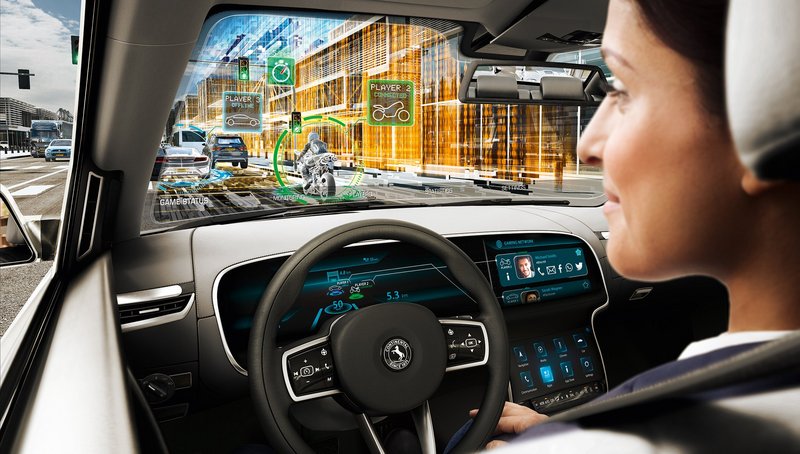Jump and Run in the Driver’s Seat? Video Games and their Influence on Automated Driving
- For the first time, Continental participates in the opening panel of the gamescom congress at the world´s largest trade fair for video games and digital entertainment
- In keeping with the motto ‘Gaming instead of Steering: The car of the future’, experts discuss new entertainment concepts for automated driving
- According to Continental, games can increase the driver´s activation and attention level during automated driving phases
Cologne, August 17, 2016. From home to the office, to a family visit or to a holiday destination – while the car was once mainly used for transportation between different areas of life, it will soon become another living space in automated driving scenarios. However, can the driver use the free time for other activities while driving, such as reading, eating, sleeping or playing? Or, could gaming even be used as a means to increase driving safety in the future? Alexander Klotz, Head of Research & Development of the Interior Division of the international technology company Continental, will be discussing these questions at the gamescom congress 2016 in Cologne. Together, with other experts in the automotive industry, Klotz will be exploring the opportunities and possibilities that arise from self driving and connected vehicles within the panel ‘Gaming instead of Steering: The car of the future’ on Thursday, August 18.
“The gamescom, one of the biggest gaming conventions in the world, is the ideal platform for a collaborating exchange between the automotive and the gaming industry. Together, we can work collectively to ensure that gaming in the car soon will not be a no-go anymore, but a fundamental and useful aspect of driver entertainment,” says Klotz.
Dr. Maximilian Schenk, the Managing Director of BIU – German Video Games Association adds: “We see a great potential for innovation and growth in the cooperation between the automotive industry and the computer and video game industry. By now, almost every second Germans play computer and video games, the biggest increase with those aged over 50 in the past years, digital games are increasingly being played on mobile devices, so playing in a self-driving car is the logical next step. Computer and video games will not only entertain the driver of a new generation vehicle, but will also make a significant contribution to a more efficient production, fuel-savings and safer driving, thanks to gamification applications.”
The driver only becomes a player with highly automated driving
Today, gaming is prohibited while driving, for obvious reasons, as the driver consistently has to deal with the task of driving, without being distracted. However, as soon as automated cars can cover longer distances, gaming scenarios in the vehicle may become more relevant. From Continental´s perspective, two factors that mainly influence the success of automated driving are: automated vehicles should be developed transparently so drivers are able to develop trust in technology and awareness for the situation. Beyond that, self-driving vehicles have to provide real added value to enhance the user experience and generate a broad acceptance. The design of secondary tasks is of great importance in this context.
“Fully self-driving cars will not become a reality overnight. Quite the contrary, automation will be introduced gradually. In the intermediate steps conditional and highly automated driving, gaming elements will play a key role in the human-machine interface,” says Klotz. “Gaming should then of course, but not only, be fun. We see the game as an active element in the vehicle cockpit, which could prevent the driver from using mobile devices. It actually involves the drivers with automated driving and supports them in reengaging in the driving task. The question of how we can keep the driver´s attention will then be, for a longer period of time, which is very important for the automotive industry. Even if the number of driving tasks decreases, the focus of the development of self-driving cars is fully on the driver.”
For safety reasons, the return of concentration and the awareness of mode and situation are of crucial importance for automated driving. That is why game scenarios in the car are not conceivable before the conditional automation level is reached and need to be controlled with operating and output elements of the vehicle. In the third of five levels of automation, the driver will no longer control the system permanently, but must still potentially be in a position to take over the steering wheel within a reasonable time frame. At this level, the game in the vehicle can particularly increase the driver´s level of activation and attention compared to the simple monitoring of the automated driving system. As a result, the probability of a successful hand over of the driving task increases – just as safety does. There is also a positive effect on the user experience, as the game entertains the driver during the monitoring.
To actively integrate the driver in the workflow and to keep him on a cognitive level, the automotive industry needs to develop new approaches to design the take over process of the driving task.
The game as a part of the human-machine interface or as an external activator
There are various possibilities for the integration of the game into the vehicle. On the one hand, it could be used as an integral part of the holistic human-machine interface and serve as a “tutor” who accompanies the drivers and tells them about system states, as one example. In this case, it actively controls the driver and can be used as an additional sensor to collect data on the driver’s condition. Or, it could be connected with the interior camera that detects driver distraction at any time and activates the driver with in-game notifications. On the other hand, the game could be integrated into the vehicle as an encapsulated unit, for example by mirroring it from mobile devices to the vehicle displays.
“In any case, the tasks of our experts for human-machine interface will change dramatically when vehicles drive automatically. Their future job will be to design the vehicle interior as more attractive than mobile phones or tablets. Only when the drivers pay particular attention to their vehicle and not to their mobile device, a real human-machine dialogue can take place in order to improve safety,” says Klotz.
The possibilities for this are manifold; Augmented Reality, holograms, head-up displays, better sound systems and graphics performance or the integration of separate computers that are independent from the vehicle´s electronics are just a few examples of technologies that can be used in the vehicle of the future. The focus of development will be on active and passive safety, as well as on issues such as seamless infotainment, driver identification or user experience. What possibilities for integration of games in the vehicle are there already? Continental is currently researching this together with the Nanyang Polytechnic Institute in Singapore.

Sebastian Fillenberg
Head of External Communications
Continental Automotive

